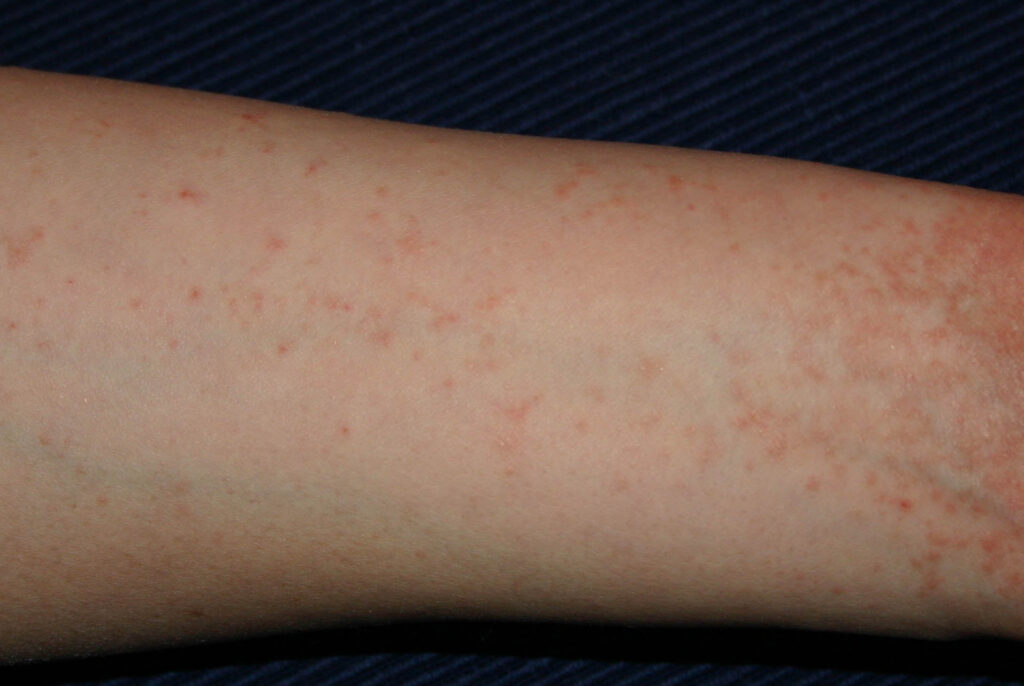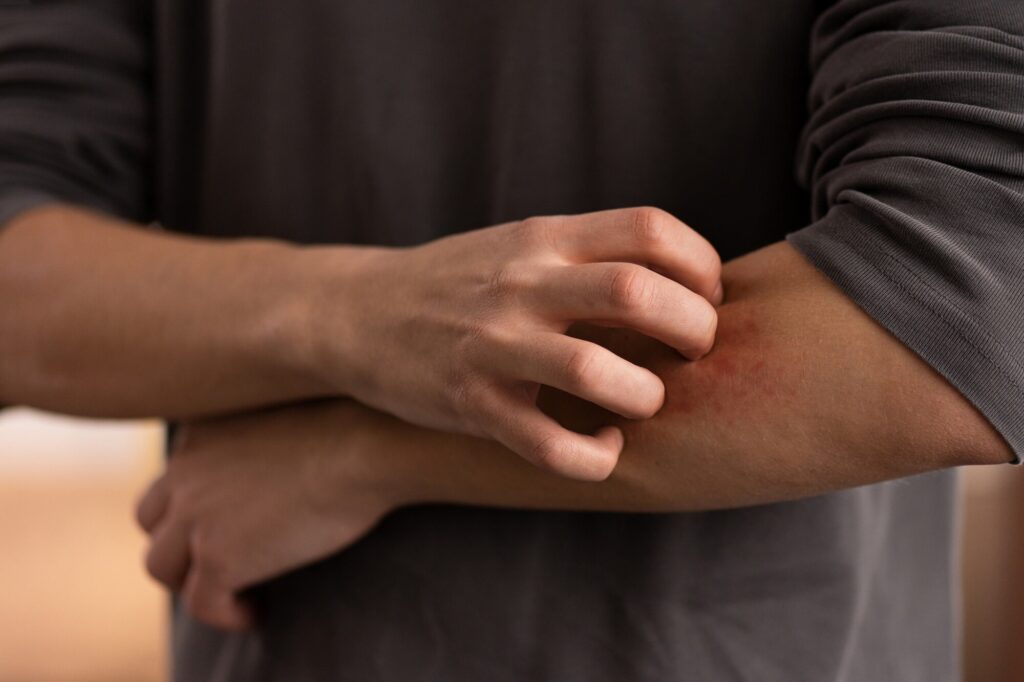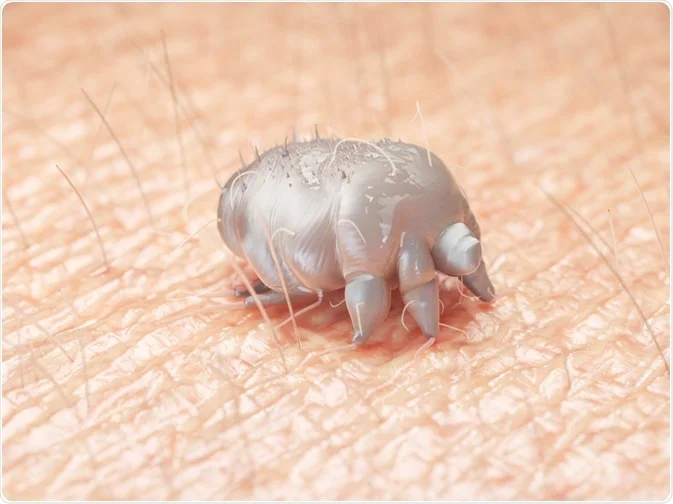Have you recently noticed tiny red dots appearing on your arms? While it’s tempting to brush off these small spots as harmless, they can sometimes indicate an underlying health issue that shouldn’t be ignored. Medical professionals in the UK are now urging people to pay attention to these skin changes, as they could be an early sign of a spreading health concern. So, what do these tiny red dots mean, and why should you take them seriously? Let’s explore this in detail.
Scabies: The Hidden Culprit Behind Tiny Red Dots

One of the most common causes of small red dots on the skin, particularly on the arms and hands, is scabies. Scabies is a contagious skin condition caused by microscopic mites that burrow into the skin’s surface, causing irritation, rashes, and—most importantly—itchy red spots.
- What Is Scabies? Scabies is an infestation by the Sarcoptes scabiei mite, which digs into the upper layers of the skin. These mites lay eggs as they burrow, leading to intense itching and the appearance of small red bumps, often accompanied by a rash.
- How Does It Spread? Scabies is incredibly contagious. It spreads through direct skin-to-skin contact, making close contact in crowded settings like schools, care homes, and dormitories particularly risky. It can also spread through shared clothing, towels, or bedding, making it a concern for those in communal living arrangements.
Symptoms to Watch For: Are Your Red Dots Scabies?
The presence of tiny red dots alone isn’t a definitive diagnosis of scabies. However, there are specific symptoms that can help you determine whether these spots could be related to a scabies infestation:
- Intense Itching: One of the hallmark symptoms of scabies is relentless itching, which often becomes more severe at night.
- Rash and Blisters: The small red dots can evolve into a rash that may blister. The rash often appears in clusters, usually around the wrists, elbows, armpits, and other folds of the skin.
- Track-Like Burrows: The mites create tiny, wavy, thread-like burrows under the skin, which appear as thin, raised lines—often near the tiny red dots.
- Skin Sores: Due to excessive scratching, sores can develop, increasing the risk of bacterial infections.
If you experience any combination of these symptoms, it’s essential to consult a healthcare professional promptly.
Why Scabies Outbreaks Are on the Rise
Recent reports indicate a significant increase in scabies cases, particularly in northern England. According to Professor Kamila Hawthorne, chairwoman of the Royal College of GPs, scabies outbreaks have surged by 100% in recent weeks. The condition itself is not life-threatening, but its spread can lead to complications like secondary infections, particularly when left untreated.
- Why the Sudden Increase? The rise in scabies cases could be attributed to factors such as increased social interaction, crowded living conditions, and delayed medical treatment due to the stigma associated with the condition.
- Who Is Most at Risk? Young adults, students, and people living in communal settings are especially vulnerable due to their higher rates of close contact. In addition, those with multiple sexual partners have a heightened risk of contracting scabies through intimate contact.
Treatment Options for Scabies: Don’t Suffer in Silence
The good news is that scabies is treatable. Medical professionals recommend prompt treatment to prevent the condition from worsening and to avoid spreading it to others. Here’s how scabies is typically managed:
- Topical Medications: Prescription creams and lotions, such as permethrin or crotamiton, are applied to the entire body to kill the mites. These medications usually need to be left on the skin for 8 to 14 hours.
- Oral Medications: In some cases, doctors may prescribe oral ivermectin, an antiparasitic medication, to clear the infestation more effectively.
- Decontamination Measures: To prevent re-infestation, all clothing, bedding, and towels used by the infected person must be washed in hot water (at least 60°C). Items that cannot be washed should be sealed in a plastic bag for at least three days to ensure any mites or eggs are killed.

The Stigma Around Scabies: Don’t Let It Stop You from Seeking Help
One of the significant challenges in managing scabies outbreaks is the social stigma surrounding the condition. Many people associate scabies with poor hygiene or neglect, which is not accurate. In reality, scabies can affect anyone, regardless of cleanliness or socioeconomic status. As Professor Hawthorne notes, the stigma should not prevent people from seeking treatment.
- Why You Shouldn’t Wait: Ignoring symptoms not only puts your own health at risk but also increases the likelihood of transmitting the mites to others. If you suspect you have scabies, don’t hesitate to consult your doctor for a proper diagnosis and treatment plan.
Preventing Scabies: Simple Steps to Protect Yourself
While scabies can be highly contagious, there are steps you can take to reduce your risk of contracting it:

- Avoid Direct Skin Contact: Minimize close contact with individuals who show signs of a rash or persistent itching.
- Don’t Share Personal Items: Avoid sharing clothing, bedding, or towels with others, especially in communal living situations.
- Wash Hands Frequently: Regular hand washing can reduce the risk of spreading the mites to other parts of your body or to others.
- Seek Treatment Early: If you notice red spots, itchiness, or any unusual skin changes, seek medical advice without delay. Early treatment not only prevents complications but also reduces transmission risk.
Conclusion: Be Proactive About Your Skin Health
Tiny red dots on your arms or other parts of your body might seem insignificant at first glance, but they can be an early warning sign of scabies or other skin conditions. By paying attention to your symptoms and seeking timely medical treatment, you can effectively manage the condition and prevent its spread. Remember, there’s no need to feel embarrassed about scabies—it’s a common condition that can be treated successfully. So, if you spot those tiny red dots, don’t ignore them. Act quickly, and protect both yourself and those around you.


